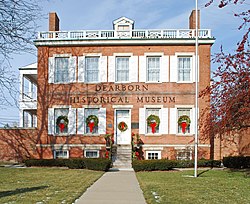Detroit Arsenal (Dearborn)
|
Commandant's Quarters, Dearborn Arsenal
|
|
 |
|
| Location | 21950 Michigan Ave., Dearborn, Michigan |
|---|---|
| Coordinates | 42°18′23″N 83°14′38″W / 42.30639°N 83.24389°WCoordinates: 42°18′23″N 83°14′38″W / 42.30639°N 83.24389°W |
| Area | 0.4 acres (0.16 ha) |
| Built | 1833 |
| Architect | Jeremiah Moors |
| Architectural style | Federal |
| NRHP reference # | 70000286 |
| Significant dates | |
| Added to NRHP | October 15, 1970 |
| Designated MSHS | August 23, 1956 |
The Commandant's Quarters at the Dearborn Arsenal is a United States military structure located at 21950 Michigan Avenue in Dearborn, Michigan. Built in the early 1830s, it is the oldest building in Dearborn still located on its original site. It is considered to be one of the seven most significant buildings in Michigan. It was designated as a Michigan State Historic Site in 1956 and listed on the National Register of Historic Places in 1970.
The building is part of the Dearborn Historical Museum, which also includes the 1831 Richard Gardner House and the McFadden-Ross House (originally the 1839 powder magazine).
In the early 19th century, the Detroit Arsenal was located in the city of Detroit. The arsenal's main purpose was to serve as a supply depot for the United States army; storing, maintaining, and repairing arms and ammunition. However, by the 1830s, the population of the city had grown such that there was fear of the stored explosives endangering the city's population. The US Congress authorized the construction of a new arsenal west of Detroit in the village of Dearbornville.
In July 1832, a site for the new Arsenal was selected located near the Rouge River on the strategically important "Chicago Road" (now Michigan Avenue) that linked Detroit to Chicago. Approximately 1,600 acres (650 ha) was set aside for a "military reservation." In July 1833, work was begun on eleven buildings comprising what was at the time called the "Detroit Arsenal at Dearbornville", The construction of the brick arsenal lasted from 1833 to 1837. The first commandant of the arsenal, Colonel Joshua Howard, proposed naming the surrounding area after Major General Henry Dearborn, a New Hampshire physician and hero of the war of Independence.
The eleven buildings of the Arsenal were spaced around a walled square, 360 feet (110 m) on a side; the ten-foot-high masonry wall was thirty inches thick and completely enclosed the square.
These eleven buildings were the following:
The powder magazine was located outside the walled square, approximately 300 yards to the east.
The arsenal was eventually judged to be no longer useful, and in 1877 the US government auctioned off the buildings. The only building remaining of the original eleven that is still in its original location and form is the commandant's quarters.
...
Wikipedia


